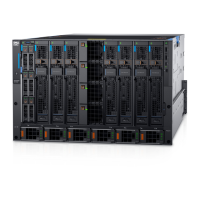From the OME-M console, specific software features can be configured:
• Configure hostname and IP management protocols, such as SNMP and NTP
• Set port status up/down and configure breakout interfaces
• Monitor system logs, alerts, and events
• Update and manage firmware
• View physical topology
• Power management
Full Switch mode has two primary use cases:
1. A network design that is not available with SmartFabric Services.
2. A network team is already in place using traditional CLI or API methods to
manage all switching devices.
A SmartFabric is a logical entity that consists of a collection of physical resources, such as
servers and switches, and logical resources, such as networks, templates, and uplinks,
that are managed as a single unit. When PowerEdge MX networking components are
placed in SmartFabric mode, the switches operate as layer 2 I/O aggregation devices.
The OME-M console supports most switch configuration settings. SmartFabric mode
supports all OS10EE show commands and the following subset of CLI configuration
commands:
• clock – Configure clock parameters
• end – Exit to the EXEC mode
• exit – Exit from the current mode
• help – Display available commands
• hostname – Set the system hostname
• interface – Configure or select an interface
• ip nameserver – Configure nameserver
• logging – Configure system logging
• management route – Configure the IPV4/IPv6 management route
• no – Delete or disable commands in Configuration mode
• ntp – Configure the network time protocol
• snmp-server – Configure the SNMP server
• username – Create or modify user credentials
• spanning-tree
▪ disable – Disable spanning tree globally
▪ mac-flush-timer – Set the time used to flush MAC address entries
▪ mode – Enable a spanning-tree mode, such as RSTP or MST
▪ mst – Configure multiple spanning-tree (MST) modes

